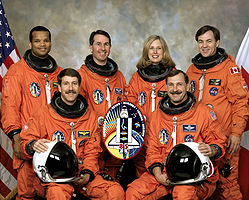STS-85
| Mission emblem | |||
|---|---|---|---|

|
|||
| Mission dates | |||
| Mission: | STS-85 | ||
| COSPAR-ID : | 1997-039A | ||
| Crew: | 6th | ||
| Begin: | August 7, 1997, 14:41:00 UTC | ||
| Starting place: | Kennedy Space Center , LC-39A | ||
| Landing: | August 19, 1997, 11:07:58 UTC | ||
| Landing place: | Kennedy Space Center, Lane 33 | ||
| Flight duration: | 11d 19h 18m 47s | ||
| Earth orbits: | 185 | ||
| Rotation time : | 90.4 min | ||
| Orbit inclination : | 57.0 ° | ||
| Apogee : | 309 km | ||
| Perigee : | 298 km | ||
| Covered track: | 7.5 million km | ||
| Payload: | CRISTA SPAS | ||
| Team photo | |||
 v. l. No. Robert Curbeam, Kent Rominger, Stephen Robinson, Jan Davis, Curtis Brown, Bjarni Tryggvason |
|||
| ◄ Before / After ► | |||
|
|||
STS-85 ( English S pace T ransportation S ystem) is the mission name for a flight of the US Space Shuttle Discovery ( OV -103) of NASA . The launch took place on August 7, 1997. It was the 86th space shuttle mission and the 23rd flight of the space shuttle Discovery.
team
- Curtis Brown (4th space flight), commander
- Kent Rominger (3rd space flight), pilot
- Jan Davis (3rd spaceflight), mission specialist
- Robert Curbeam (1st spaceflight), mission specialist
- Stephen Robinson (1st spaceflight), mission specialist
-
Bjarni Tryggvason (1st space flight), Payload Specialist ( CSA / Canada )


Originally Jeffrey Ashby provided as a pilot, but he was replaced in March 1997 by Kent Rominger, of a space flight only in December 1996, STS-80 was performed.
Mission description
A few hours after the start put the Discovery crew the German research satellite CRISTA-SPAS ( Cr yogenic I nfrared S pectrometers and T elescopes for the A tmosphere out to its second mission). The focus of his work was the exploration of the middle layers of the earth's atmosphere . With special telescopes and spectrometers , temperature, trace gases and currents in the middle atmosphere were measured, in particular the concentration of ozone and substances that decompose ozone. High ice clouds in the polar stratosphere (PSCs) and mesosphere (PMCs), as well as large flow systems in the atmosphere, similar to ocean currents, were also discovered. For direct data reception it was necessary to keep a distance of 40 to 100 kilometers from the satellite at all times. In total, more than 150 orbit maneuvers were necessary.
Another item on the program was the test of a Japanese robotic arm ( Manipulator Flight Demonstration MFD ) for the ISS space station . With its help, complicated work was carried out, such as loosening screws and opening doors. The manipulator moved along a lattice structure that was anchored in the payload bay. Operation via a computer display was also possible when the object to be detected was not directly visible. In this way, the robotic arm could also be operated from a ground station.
A total of 24 scientific studies in the fields of technology, medicine , ecology and astronomy were carried out. The latter included observations of Comet Hale-Bopp with an 18-centimeter ultraviolet telescope. With it, 30 images per second were electronically recorded through 7 different filters in several three-hour observation series. The cargo bay also contained an extreme UV spectrograph for observing the sun, other stars and other celestial bodies, another UV spectrograph for astronomical planetary research and an experiment designed by students to measure solar radiation in the UV and X-ray range.
A remote-controlled experimental complex ( Technology Applications and Science TAS ) in the payload bay comprised investigations to determine the solar constants and the thermal radiation of the sun (infrared radiometer) as well as to measure cloud heights, soil profiles and surface vegetation with a laser range finder. In addition, devices for temperature control and long-term cooling (Experiment Cooler ) were tested. The Space Vision System was used again, with which the signals from several cameras could be digitally compressed and transmitted to the ground station via a television channel.
Further experiments related to the observation of combustion processes in weightlessness , the investigation of the growth of cancer cells in the Bioreactor Demonstration System BDS and the detailed test of a further developed platform floating on a magnetic field that is supposed to dampen the movements of the space shuttle to such an extent that experiments taking place on it cannot can be significantly disturbed ( MIM experiment ). Smaller computer problems with MIM, MFD and TAS were largely eliminated.
The very successful mission ended one day later than planned on runway 33 of the Kennedy Space Center , Florida because of ground fog at the landing site .
See also
Web links
- NASA Mission overview (English)
- Video summary with comments of the crew (English)
- NASA video of Mission (English)
- CRISTA website of the University of Wuppertal
Individual evidence
- ^ Rominger to Replace Ashby as STS-85 Pilot. In: Release: 97-42. NASA, March 18, 1997, accessed March 19, 2010 .
